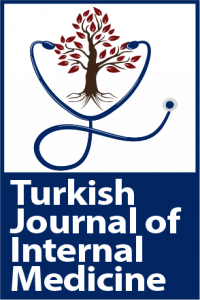Q Fever in the Differential Diagnosis of COVID 19 Infection
Q Fever in the Differential Diagnosis of COVID 19 Infection
Q Fever, Coxiella burnetii, COVID 19,
___
- WHO COVID-19 Case definition. Available at: https://www.who.int/publications/i/item/WHO-2019-nCoV Surveillance_Case_Definition-2020.2
- COVID-19 Rehberi. Available at: https://covid19.saglik.gov.tr/TR-66301/covid-19-rehberi.html
- Eldin C, Mélenotte C, Mediannikov O, Ghigo E, Million M, Edouard S, et al. From Q Fever to Coxiella burnetii Infection: a Paradigm Change. Clin Microbiol Rev. 2017;30(1):115-90.
- Köksal E, Günal Ö, Kılıç SS. Q fever: An occupational disease. Klimik Derg. 2020; 33(2): 195-6.
- Asan A. KLİMİK 2015 XVII. Türk Klinik Mikrobiyoloji ve İnfeksiyon Hastalıkları Kongresi Kitabı. 2015; 87-8.
- Çelebi B, Baş B, Agüloğlu Bali E, Şimşek Yavuz S. Endokarditli Bir Olgudan Coxiella burnetii’nin Türkiye’de İlk İzolasyonu; Antijen Üretimi ve Faz Değişimi Çalışması. Mikrobiyol Bul. 2019;53(3):274-84. doi: 10.5578/mb.68336
- Coleman JJ, Manavi K, Marson EJ, Botkai AH, Sapey E. COVID-19: to be or not to be; that is the diagnostic question. Postgrad Med J. 2020;96(1137):392-8. doi: 10.1136/postgradmedj-2020-137979.
- Vink M, Vink-Niese A. Could cognitive behavioural therapy be an effective treatment for long COVID and post COVID-19 fatigue syndrome? Lessons from the Qure Study for Q-Fever Fatigue Syndrome. Healthcare (Basel). 2020 Dec 11;8(4):552. doi: 10.3390/healthcare8040552.
- Park HS, Bae PK, Jeong HW, Son BR, Shin KS. Serological evidence of Coxiella burnetii and SARS-CoV-2 co-infection: A case report. Ann Lab Med. 2021;41(5):510-3. doi: 10.3343/alm.2021.41.5.510
- Başlangıç: 2019
- Yayıncı: Nizameddin KOCA
Özlem ÖZDEMİR, Hamza ÇINAR, Çağrı AKALIN, Mürüvvet AKÇAY ÇELİK
Öznur SARI, Ahmed Muhammad BASHİR
Langerhans Cell Histiocytosis In Bone: A Case Report
Orkide KUTLU, Gizem MERAL, Hasan ERUZUN, Özlem BULUZ, Ayça Zeynep KUTLU, Suat Erol ÇELİK
Relation Between Microvascular and Macrovascular Hemodynamics in Normal Epicardial Coronary Arteries
Cafer PANÇ, Onur ERDOĞAN, Remzi SARIKAYA, Mehmet KOCAAĞA, Pelin ÖZER, Berrin UMMAN
Q Fever in the Differential Diagnosis of COVID 19 Infection
Sevil ALKAN, Alper ŞENER, Safiye Bilge GÜÇLÜ KAYTA, Anıl AKÇA
Mahdieh ARDANEH, Fatemeh TAVAKOLİ-FAR, Atefeh PAYANDEH, Ehsan AMİRİ-ARDEKANİ
Onur ELBASAN, Pınar ŞİŞMAN, Hande PEYNİRCİ, Ayşegül YABACI, Canan ERSOY
